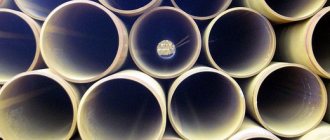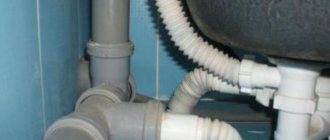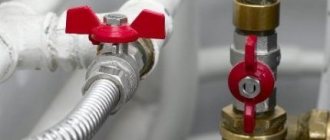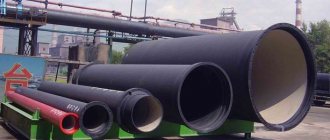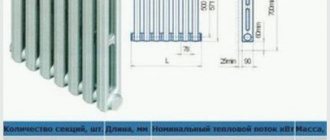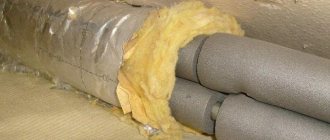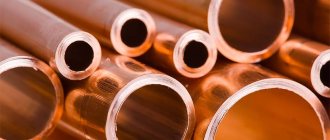The performance qualities of a steel pipe have been surpassed by many products made from modern materials, but it is still ahead in terms of strength, resistance to temperature and pressure. The main reason why a steel pipeline is inferior to competitors is corrosion, but this issue has also found a worthy solution. Protecting steel with galvanization made it possible to obtain a reliable and durable material for the construction of water pipelines.
Galvanized products are used for water supply installations much less frequently than other types of pipes, due to the properties of zinc and installation features
Standard service life of steel pipes according to GOST
One of the important characteristics of the product is, among other things, the period of operation. Any material wears out over time, but this time can be very different and depends on the load, on additional factors and, of course, on the quality of the product itself. The standard service life of steel water pipes largely determines their purpose.
Types of pipeline
Several types of metal products are used in heating and water supply systems:
- black steel pipes - steel of different grades is used in production, but it is not corrosion resistant. Such rolled metal products require additional protection - painting, for example;
- galvanized steel pipes - products are coated with a layer of zinc. The latter forms a galvanic couple with iron and is destroyed by an electrochemical reaction, protecting the steel from corrosion. Obviously, the service life according to SNiP and GOST for such a model is much longer;
- stainless steel – alloys with the addition of nickel and chromium. Depending on the size of the alloying additive, steel can be resistant to corrosion under normal conditions, is characterized by increased resistance, which allows use in sea water, for example, and also does not oxidize under the influence of not only moisture, but also high temperature. The product does not need protection, however, its cost is noticeably higher;
- copper - rare, but used in domestic conditions. They are distinguished not only by their resistance to corrosion, but also by their disinfecting properties.
Each option from the list can be used for water supply, gas pipelines, heating, and not only water, but also steam. However, their service life will vary.
Alas, this option is not particularly durable. Even with the most careful painting and care, they will rust over time. The fact is that after the construction of communications, individual fragments turn out to be inaccessible, and it turns out to be impossible to update the paint, for example.
In addition, black steel loses its smoothness quite quickly. And this leads to the fact that the water-gas or heating pipe “overgrows” quite quickly: first very small debris and salt deposits are retained on the unsmooth surface, and then increasingly larger particles of rust, fibers, and lime deposits. The rate of sediment accumulation is directly proportional to water hardness.
Constant contact with moisture - in the bathroom, for example, in the toilet, leads to faster destruction of the material, which is reflected in SNiP standards. Here the weak link is often the seams: the first fistulas appear precisely on the welds and threads, where the wall thickness decreases.
Standard operating times are:
- the service life of steel water pipes - riser or liner - is 15 years;
- the heating system assembled from gas steel pipes is suitable for use for 10 years;
- heated towel rails in the bathroom can “work” for 15 years;
- According to GOST, the standard service life of a gas pipeline made of steel pipes is 30 years.
In fact, destructive factors of various kinds significantly reduce the operating time. For example, a pipeline with cold water wears out much faster than with hot water, since it rusts faster: condensation appears in the warm season. And the pipeline overgrows faster, since hot water contains special additives that prevent this.
Cink Steel
This material is much more resistant to corrosion, which significantly extends the standard time. The most significant destructive factor here is only the welded connection, if for some unknown reason the installation is carried out by welding. The photo shows water and gas steel pipes.
In fact, this installation method is prohibited: the zinc completely burns out during welding, and accordingly, the seams remain completely defenseless against rust.
Galvanized steel products overgrow much more slowly. Firstly, the smoothness of the wall is much higher, and secondly, there is much less “garbage” itself - particles of rust, scale, sand. But if the taps in the plumbing system are not fully opened and there is not a sufficiently dense flow of water, scale and sand can accumulate.
The service life of the product according to GOST is as follows:
- risers and connections in cold water supply systems are in use for 30 years;
- the service life of steel heating pipes in a house with a closed system is 20 years;
- an open heating system will last 30 years.
It is allowed to construct a gas pipeline from galvanized pipes. But there is still a nuance: unlike plumbing systems, the gas pipeline must be one-piece, which requires welding. And the connection destroys zinc at the junction. On the other hand, gas pipelines, like water pipelines, are coated with polymer paint, which prevents corrosion.
In fact, galvanized steel pipes for both water supply and heating last 50–70 years.
Source: https://TrubyGid.ru/sroki-sluzhby-trub
Standard service life of water pipelines
The length of networks (in single-pipe measurement) in Russia is impressive - it is more than 1 million km! At the same time, about 30% (!) of pipelines are so worn out that they need urgent replacement and repair. Let's take a closer look at the different types of pipelines (water supply, heat supply, sewerage), their condition and problems arising due to their wear and tear and poor quality.
The total length of water supply networks is more than half a million km and approximately 30% of them need replacement and repair. What are the dangers of old steel pipelines overgrown with rust?
It is worth noting that the quality of heating mains is most relevant specifically for Russia, because
We have the highest level of centralized heating supply (up to 80%). Due to the moistening of the materials used during operation, the heat-protective properties of thermal insulation structures are sharply reduced, which leads to heat losses that are 2-3 times higher than the standard ones.
Basic requirements for the technical operation of water supply systems
56.
Before commissioning, after all installation and repair work has been completed, water supply systems are tested using the hydrostatic or manometric method in compliance with the requirements of GOST, GOST and SNiP 3.01.01-85.
In winter, the test is carried out only after the heating system is put into operation.
In cases where it is difficult to carry out hydrostatic tests, a manometric test is carried out. The testing of the system is documented in a document.
Standard service life of water supply pipelines
Steel pipes are characterized by low cost, but the cost of their installation is high.
Some experts claim that the service life of steel pipes is the same, if not longer, than that of houses - KHRUSHCHEVK and BREZHNEVOK - the house will fall apart faster than the cold and hot water risers rust and will not stand! Nowadays, it is not uncommon for housing and communal services to replace perfectly serviceable pipes only in order to “saw off” a lot of money allocated for pipe replacement into their bottomless pockets.
The maximum service life is the time of exposure to constant temperature and pressure on the pipe, which it can withstand without destruction, taking into account the reliability factor. The use of polyethylene pipes is safe and environmentally friendly, i.e.
Service life of steel water supply pipes according to GOST
Obviously, the service life according to SNiP and GOST for such a model is much longer; Each option from the list can be used for water supply, gas pipelines, heating, and not only water, but also steam.
However, their service life will vary.
Black steel for water supply Unfortunately, this option is not particularly durable.
True, its cost is somewhat higher, but at the same time such a pipe: is practically not subject to corrosive destruction; has high resistance to chemically aggressive substances; from an environmental point of view it is absolutely safe; has the highest mechanical strength and heat resistance; the coefficient of thermal expansion of steel is 1.5 times lower than that of copper, and 6 times lower than that of plastics, which allows such pipes to be laid directly in the floors.
Standard service life of steel pipes according to GOST
Several types of metal products are used in heating and water supply systems: black steel pipes - steel of different grades is used in production, but it is not corrosion resistant.
Depending on the size of the alloying additive, steel can be resistant to corrosion under normal conditions, is characterized by increased resistance, which allows use in sea water, for example, and also does not oxidize under the influence of not only moisture, but also high temperature.
Standard service life of hot water pipelines
This is not at all strange, because they are not subject to corrosion, and their service life is many times greater than the “life expectancy” of steel ones.
This is clearly visible in Table 1. Table 1. Construction technologies" No. 4, 2004 Without pipes it is impossible to imagine the life of not only an individual house or enterprise, but also entire districts and cities. Pipes are used to move cold and hot water, to create heating mains, sewerage systems, and for many other purposes.
The length of networks (in single-pipe measurement) in Russia is impressive - it is more than 1 million km! At the same time, about 30% (!) of pipelines are so worn out that they need urgent replacement and repair.
Service life of water pipes
The quality of living in a country house or apartment building largely depends on what kind of water pipes were installed in it.
In this article we will look at several types and characteristics of pipes for home plumbing.
Since then, the metal sewer system has undergone almost no changes. In modern houses and apartments you can see sewer pipes made of the following types of metals: Sewer pipes made of polymers appeared in apartments only at the turn of the 20th and 21st centuries.
Service life of metal water supply pipes: standard and actual service life of the water supply system
No, this is not the Alien's digestive system. Just the insides of an old water supply pipe. How long do metal pipes last for water supply? Today we have to rummage through the regulatory documentation to find the answer to this question and find out why the service life of pipelines is being reduced.
Actually, there are currently only four of them:
- Corrugated stainless steel.
- Black steel (water and gas pipes GOST 3262-75);
- Galvanized steel, produced to the same standard;
- Copper;
It’s interesting: just a few decades ago, cold water supply lines were massively laid with cast iron pipes.
Service life of steel structures
Not long ago, one of our readers inquired about the service life of steel pipes in an apartment. And she really wanted to get a link to some official document.
We actually managed to find something. Not a “law”, of course, but still... This regulatory act establishes the following service life of steel structures: 1.
For central heating pipelines – 30 years.
2. For water supply and sewerage steel pipelines – 15 years. The same galvanized steel pipes will last 2 times longer (30 years).
3. For steel enameled bathtubs and sinks – 15 years.
4. For drainpipes made of galvanized steel – 15 years, for drainpipes made of black steel – 5 years. 5. For roofing: a) from black roofing steel – 15 years.
Source: https://152-zakon.ru/normativnyj-srok-ehkspluatacii-vodovodov-12444/
What is the standard service life of water pipes?
The reality of our life is that there is no regulatory document regulating the service life of steel water pipes, although there is an instruction from 1971, which, unfortunately, is better not to refer to, because it is outdated in every way.
There is a term “average standard service life of a pipe,” defined as 20-25 years, which is used in most calculations.
And the point is not in bad technical “legislation”, but in the pipe itself, since the same pipe under different operating conditions can last for different times.
Despite the fact that plastic is everywhere replacing traditional materials, all important structures are still made of metal, including water mains.
For some reason, we have adopted a “standard” for water pipes that the degree of wear is the complete failure of the system, when repair clamps are installed on the clamps.
However, before determining the service life of steel water pipes, it is necessary to clarify that this period is calculated from the moment the pipeline is launched, and not from the manufacture of the pipe, since there are “stale pipes” on sale.
PVC pipes service life, service life of plastic pipes
- Safety, non-toxic and non-flammable raw materials.
- Practicality in use and when laying highways.
- Light weight.
- Possibility of long-term operation without clearing blockages.
- Absolute neutrality to corrosion and aggressive substances.
- Resistance to various living microorganisms.
- High durability.
Interesting: At what age should a child get a bus ticket?
The service life of PVC sewer pipes, according to manufacturers, is more than 30 years. However, when purchasing such polyvinyl chloride products, it is necessary to take into account the conditions under which the pipeline model will be operated and what potential factors affecting it exist.
For example, it is necessary to take into account the exposure of collectors to external environmental influences (weather conditions, ultraviolet light, etc.) and indoor humidity levels. It also doesn’t hurt to assess the likelihood of mechanical impact from outside and the risk of microorganisms multiplying inside the system.
What is the service life of steel pipes for water supply and heating - material characteristics
This pipe product is characterized by good thermal conductivity, and the insignificant expansion coefficient due to temperature changes makes it possible to lay water pipes in the wall. Steel pipes, in addition, are excellent for arranging radiant types of water heating.
The service life of heating pipes made from steel is more than 20 years. They are laid both underground and in the basements of multi-story buildings, where very hot coolant moves along them with an internal pressure exceeding 6 atmospheres.
Standard service life of external steel water supply pipes
In this article we will look at several types and characteristics of pipes for home plumbing. Modern pipe manufacturers use a range of structural materials in the manufacture of their products. However, currently, only plastic or metal pipes are used in water supply systems.
The documents for the pipe according to GOST 3262-75 do not provide a service life. When using galvanized steel pipes in accordance with GOST 3262-75, their service life will depend on the operating conditions. Duration of operation before major repairs (replacement)": Cold water pipelines from galvanized pipes - 30 years (residential buildings), 25 years (municipal facilities).
Standard service life of external water pipes
Their throughput with an equal internal cross-section is lower than that of copper or polymer products. This is explained by the fact that the surface of steel pipes is rough on the inside, which prevents the free movement of liquids due to the formation of turbulence.
If we accept losses in the amount of 30% of the volume of water supplied to the network (25 billion m3), and the cost of 1 m3 of water is 30 rubles, then the cost of annually lost water will be 225 billion rubles.
District heating pipelines These pipelines supply hot water for heating and hot water supply systems.
Of approximately a third of a million km of heating networks (in single-pipe measurement), approximately a sixth are in need of replacement and repair.
Interesting: Validity of a driver’s medical certificate in 2019
How long can steel pipes last in an apartment building?
The massive use of steel water pipes in Soviet times and in modern Russia is explained by their availability, manufacturability and the quite acceptable standard service life of pipelines made from them, providing water supply and sewerage drainage in apartments of multi-storey buildings. Rolled metal can withstand loads resulting from pressure surges.
Among the disadvantages of metal pipelines, it is worth noting the significant costs of installation work. To arrange communications, gas welding equipment is required. In addition, the significant weight of the pipes imposes additional difficulties on the process of transporting and lifting them to the work site in a high-rise building.
The service life of pipes is directly dependent on the properties of the materials used.
Such network systems behave well under water, in the ground, and in workshops; they are even used for systems operating under pressure. Plastic is interesting because of its speed of installation, low weight, and good strength and toughness. A win-win option is to use these profiles for indoor or outdoor sewerage.
Such pipes are very promising because they do not require any maintenance, they are chemically neutral, salt does not accumulate on the walls, condensation does not form, heat loss is minimal, and this allows you to do without thermal insulation. All these properties, combined with service life, make polypropylene systems the No. 1 material .
26 Apr 2021 glavurist 546
Source: https://mainurist.ru/nedvizhimost/kakoj-normativnyj-srok-ekspluatatsii-vodoprovodnyh-trub
How long can steel pipes last in an apartment building?
The massive use of steel water pipes in Soviet times and in modern Russia is explained by their availability, manufacturability and the quite acceptable standard service life of pipelines made from them, providing water supply and sewerage drainage in apartments of multi-storey buildings. Rolled metal can withstand loads resulting from pressure surges.
Among the disadvantages of metal pipelines, it is worth noting the significant costs of installation work. To arrange communications, gas welding equipment is required. In addition, the significant weight of the pipes imposes additional difficulties on the process of transporting and lifting them to the work site in a high-rise building.
Should I choose steel water pipes and what will be their service life?
The design and installation of steel water mains is carried out depending on the material from which they are made.
The service life of a water pipe depends on the quality of the liquid for which the pipeline is used.
An aggressive environment quickly damages the line from the inside if it is not protected with a special coating against chemicals. The service life of steel water pipes depends on the type of structure.
Types of structures
The designs are:
- Suture. They are not used in home heating systems, since bending breaks the integrity of the seam and causes it to separate. When producing this type, the seam is not processed from the inside, so leaks occur in such places and replacement will be required. The maximum that can be expected from such a pipe is 3 - 5 years.
- Seamless. More reliable products. The service life of such water pipes can last up to 20 - 30 years, subject to care and timely cleaning of lime deposits and iron oxide. New production technologies make it possible to use special coatings for highways - enamel, ceramics, zinc, which increase the service life and allow you to go without repair or replacement for a long time.
Steel structures are used not only for water, but also for gas and oil pipelines. The duration of use is regulated by GOST standards. The regulatory documentation also specifies test methods, acceptable welding methods, connection possibilities, technical capabilities of steel pipes - throughput, resistance to pressure and temperatures.
Standard service life of water supply steel pipes according to GOST
There is no state standard for the service life of steel pipe structures.
The average working life of steel mains is about 20 - 25 years, subject to proper operation and professional installation.
The duration of operation of water supply structures depends on the quality of steel, wall thickness, additional insulation against condensation or anti-corrosion coatings.
The characteristics of steel lines may vary depending on the composition of the pumped liquid, its temperature and pressure. The remaining service life of used pipes is determined by an expert commission. Wear calculation is calculated
the ratio of the actual service life to the standard one, the resulting value is multiplied by a factor of 300.
Galvanized water pipes
Galvanized steel pipes are a durable material for the construction of water supply systems. Their technical features are:
- resistance to rust formation inside;
- resistance to increased pressure;
- protection against the negative effects of high temperature;
- absence of harmful compounds that can get into food with water.
Non-ferrous metals do not form rust. Zinc is one such metal. They cover both the inside and outside of the water pipe. The service life of the pipeline depends on the thickness of the applied coating, as well as on the application method. Galvanizing is allowed in several ways:
- Thermal diffusion method. In a closed container, the steel is exposed to zinc vapor at high temperatures. With this treatment, complete adhesion of steel and zinc particles occurs, which makes it possible to obtain a dense, evenly distributed coating over the entire area of the pipe.
- Hot galvanizing. The prepared pipe is immersed in molten zinc at temperatures up to 450 degrees. With this method, non-ferrous metal fills the threaded connections and lays down in an uneven layer - there are sagging and thickening. The method is uneconomical.
- By electrolysis method. The layer of non-ferrous metal is uniform, but does not have strong adhesion to the steel surface, which in the future can provoke chips and cracks in the coating. The porous structure of the zinc layer allows aggressive liquids to penetrate and damage the steel.
Depending on the purpose of galvanized steel structures, a coating method is chosen - more or less reliable.
Galvanized lines have a number of advantages over simple steel pipes during operation:
- thermal expansion deforms structures less;
- resistant to mechanical damage;
- a smooth internal surface increases the throughput of the pipeline, which reduces the risk of the pipe section becoming overgrown with foreign deposits - lime, sand, dirt;
- withstand pressure up to 1.6 MPa;
- resistance to iron oxide damage for 20 years or more.
It is not recommended to use galvanized elements when organizing wells for home water supply. Contact with the ground changes the chemical parameters of water, and corrosion may form at the joints due to damage to the zinc coating during welding.
The safest and longest lasting galvanized lines can be used to deliver cold water with a high pH - from 7.5 to 8.5. This is rare for a city water supply, since not everywhere there are installations for high-quality wastewater treatment and reducing its acidity.
Hot water increases the rate of corrosion formation by 5 times, and temperature fluctuations inside the pipe cause the destruction of the protective coating.
Connections between galvanized and copper pipes also reduce the quality of the coating, since copper ions act aggressively and reduce the life of the pipeline.
According to regulatory data, galvanized steel structures:
- should not have cracks or swelling;
- may have traces of stripping if the protective coating layer is not reduced to the maximum permissible values;
- the end parts should not have delamination or nicks exceeding 0.5 mm;
- The cut is made at a right angle, the bevel is no more than 2 degrees.
The sections may not have a zinc coating, as they are intended for welding. Coupling connections are covered with a full protective layer with a thickness of at least 30 microns.
Ferrous metals for plumbing
Compared to materials that have a variety of protective coatings, water supply structures made of ferrous metals are a budget-friendly and not the most reliable option for arranging a water supply system.
Carbon steel lines have the following disadvantages during operation:
- They are susceptible to condensation, so additional insulation of the outer layer is required. Excess steam promotes corrosion.
- Reduction in internal diameter due to sediment in areas where the water contains salt impurities. Deposits on the internal walls reduce the performance of water pipes made from steel pipes.
- Makes installation work difficult.
- They have an unaesthetic appearance.
- The service life declared by the manufacturer does not correspond to the actual one, and the pipes have to be replaced faster. It is impossible to predict how long the structure will last.
The advantages of steel water supply are:
- low cost;
- high resistance to temperatures and deformations;
- resistance to mechanical damage.
According to GOST, pipe lines must operate for a maximum of 20 years, but much depends on the quality of installation work and the chemical composition of the transported liquid.
Is it worth choosing steel pipes for water supply?
In an apartment building, the pipeline is installed with the expectation of 30 years of operation. Steel can withstand this period quite well. Blockages caused by the accumulation of sand, lime, and corrosion can reduce the performance of the pipe. In order for steel structures to last longer, they have to be professionally cleaned from time to time, which requires additional financial costs.
The use of metal pipes from the cheap segment in apartment and private buildings is unjustified, since replacing a pipeline is a costly process and involves turning off water for several days.
It is better to choose from materials coated with special compounds - zinc, chromium, ceramics, enamel. Such materials are more expensive to purchase and install, but they last longer and do not require frequent maintenance and cleaning.
A special feature of a steel pipe with chromium additives is its stated service life of more than 100 years, but there are contraindications for chlorine, which has an aggressive effect on stainless steel, so before purchasing you need to check the amount of dissolved chlorine in the water supply.
Should I choose steel water pipes and what will be their service life? Link to main publication
Source: https://trubyda.ru/vodoprovodnye/srok-sluzhby-stalnyh-trub
Connection of galvanized water pipes
The connection of a galvanized pipeline is possible by welding or threading. It is obvious that violation of the integrity of the protective layer leads to corrosion and the joints are subject to this risk to a significant extent, so the installation of these systems requires a special approach.

Most often, galvanized pipes are installed using threaded fittings of various shapes
The threaded connection is used for installation of round galvanized pipes. A steel pipe product with factory-applied threads at the ends after diffusion galvanizing is fully protected and ready for threaded connections using galvanized fittings (couplings, nipples, reductions, plugs, adapters, corners, etc.). The joint is sealed by wrapping tow and painting. During hot-dip galvanizing, the threads often become swollen and have to be repaired again. The connection using a thread, made in accordance with all the rules, is reliable and airtight, safe for the water supply, does not corrode, and is convenient for further replacement and repair.
Welding joints for galvanized products were previously considered inapplicable, since at high temperatures the zinc burned out and the joint became vulnerable. In addition, zinc vapors lead to serious poisoning. However, today there are several known methods for welding joints of galvanized steel products without damaging the protective coating. The welding method is suitable for installing all types of pipes, both round and profile, of any cross-section.
The basis for welding galvanized products is the task of preventing the evaporation of zinc from the surface of the steel. To do this, a layer of flux is applied to the pipes at the junction, which prevents the protective layer from burning out. The filler rod is melted by the flame of the torch, forming a weld. In this case, zinc melts, but does not burn out, then solidifies again. This type of connection is used for installing a water supply system; the flux residues inside are gradually washed out with water without harming the drinking qualities.
Also, during semi-automatic welding, liquefied food-grade carbon dioxide is used as a protective medium to preserve zinc. In the weld area, the zinc layer is cleaned off, since its oxides contribute to the electrode spattering, which makes the seam porous. For gas-electric welding of thin-walled galvanized pipes (up to 5 mm), overhead copper rings are used, which are then removed, preserving the integrity of the zinc coating.
Service life of metal water supply pipes: Standards | My well
No, this is not the Alien's digestive system. Just the insides of an old plumbing
How long do metal pipes last for water supply? Today we have to rummage through the regulatory documentation to find the answer to this question and find out why the service life of pipelines is being reduced. Let's get started.
Announce the entire list
First, let's remember exactly what types of metal pipes are used in cold and hot water supply systems.
Actually, there are currently only four of them:
- Black steel (water and gas pipes GOST 3262-75);
- Galvanized steel, produced to the same standard;
- Copper;
- Corrugated stainless steel.
It’s interesting: just a few decades ago, cold water supply lines were massively laid with cast iron pipes. However, now they have been almost completely replaced by pressure polyethylene ones.
A cast-iron water supply system, built more than two centuries ago, feeds the famous fountains of Peterhof
Black steel
Steel rusts. It rusts especially quickly with prolonged contact with water. That is why the service life of steel risers and connections laid down in the regulatory documents, frankly speaking, is not amazingly long.
The main document establishing the standard service life of utilities in a residential building is VSN (departmental building codes) number 58-88, adopted in 1988. They regulate the timing of maintenance, reconstruction and repair of buildings.
The document regulates the procedure for repair and reconstruction of buildings
Appendix No. 3 to the document provides the following figures:
| Engineering system element | Standard service life, years |
| Riser or cold water supply from gas pipes | 15 |
| A riser or hot water supply from gas pipes in a building with a closed heating system (without taking hot water from the heating system) | 10 |
| The same, in a building with an open heating system (DHW is taken from the heating circuit) | 15 |
| Heated towel rails in the DHW system | 15 |
Destructive factors
What factors limit the service life of VGP pipes without anti-corrosion coating:
| Image | Description |
| Steel water supply risers. The first fistula that caused the ceiling to become wet appeared in the ceiling | Corrosion. Rusting of the pipe is accelerated by a damaged outer layer of paint, frequent shutdowns of the water supply (in this case, the unpainted inner surface of the pipe is in contact with air with high humidity) and poor ventilation in the bathroom (read: consistently high humidity). The first fistulas appear on longitudinal welds (VGP pipes GOST 3262 are electric welded), on threads where the thickness of the pipe walls is minimal, and in ceilings where the surface of the pipes is not ventilated and (in the case of cold water risers) is continuously wetted by the condensate falling on them. |
| Lime deposits and rust have almost completely blocked the gap in the water pipe | Overgrowing of pipes with deposits (primarily lime salts) and rust.
|
| The diameter of steel risers is selected taking into account the reduction in pipe capacity due to deposits | Pipeline diameter. The larger the internal cross-section of the pipe, the longer it maintains acceptable throughput. |
| The thicker the wall, the longer the pipe can resist corrosion. | Wall thickness. According to GOST 3262, ordinary, reinforced and lightweight pipes are produced. It is clear that those reinforced before the first through fistulas appear will last longer. |
Please note: a steel line overgrown with deposits can often be cleaned with a steel cable or string. Even more effective destruction of deposits is ensured by chemical flushing of the water supply system: an alkaline or acidic environment dissolves lime and iron oxides.
Chemical flushing can transform old plumbing
Actual service life
In the author’s memory, the minimum trouble-free service life of a steel cold water supply system in a new building was only 10 years.
The house was built and delivered shortly before the collapse of the Union, in conditions of austerity on building materials and the actual inoperability of Soviet norms and standards.
Lightweight VGP pipes, purchased for reasons of economy, quickly and en masse began to leak at welded joints and threads.
By the way: despite the same standard service life specified for black steel pipes in cold water and hot water systems, cold water pipes fail much faster. They rust intensively due to the condensation that falls on their surface during the hot season and quickly become overgrown with deposits due to the lack of additives that dissolve lime and rust in drinking water.
The photo shows the typical condition of a cold water supply riser after 20 years of service.
The oldest engineering systems made of black steel have been in service for more than half a century.
In addition to the large thickness of the pipe walls, their longevity is facilitated by:
- Low humidity levels;
- No condensate on cold water pipes;
- Periodic painting of risers and liners;
- Low content of mineral salts in water.
Standard service life
We can find data about him in the same VSN 58-88:
| Engineering system element | Standard service life, years |
| Riser or liner in a cold water supply system | 30 |
| Riser or hot water supply in a house with a closed heating system | 20 |
| The same, in a house with an open heating system | 30 |
The photo allows you to compare the condition of black pipes and galvanized pipes after storage under the same conditions
Copper
The next metal on our list is copper.
Copper water supply: stylish and durable
How long can these metal hot water pipes last? There are no regulatory documents establishing specific service periods. Manufacturers promise a vague “50+” years.
In practice:
- The oldest copper water pipes have been in service for more than a century and are still in perfect condition;
- Copper does not degrade over time, is not subject to corrosion and is only afraid of significant mechanical stress: the metal is very plastic, and the pipe walls are only about a millimeter thick.
Corrugated stainless steel pipe
How long will corrugated stainless steel last in a water supply?
According to one of the leading manufacturers, the Lavita company - indefinitely. Lavita explicitly states that its products have an unlimited service life.
Characteristics of Lavita corrugated pipes. Please note maximum pressure and service life
However: silicone seals in press fittings will still have to be changed after 30 years. This work is not difficult: the fitting can be disassembled to replace the seal with a pair of adjustable wrenches in 30-60 seconds.
What is the actual service life of stainless steel in water supply cannot yet be said simply because of the limited time of its operation.
The service life of pipes is directly dependent on the properties of the materials used.
Such network systems behave well under water, in the ground, and in workshops; they are even used for systems operating under pressure. Plastic is interesting because of its speed of installation, low weight, and good strength and toughness. A win-win option is to use these profiles for indoor or outdoor sewerage.
Such pipes are very promising because they do not require any maintenance, they are chemically neutral, salt does not accumulate on the walls, condensation does not form, heat loss is minimal, and this allows you to do without thermal insulation. All these properties, combined with service life, make polypropylene systems the No. 1 material .
Articles on the topic

The condition of water pipes requires special attention from plumbers working in the management organization. In the article we will talk about the types of metal pipes, their features and service life - both those prescribed in regulatory documents and real ones. To help the Criminal Code, we also provide a list of mandatory work that must be carried out as part of the maintenance of water pipelines in multi-storey buildings.
15-20 years ago, polymer pipelines began to appear in residential buildings. Previously, during construction, exclusively metal communications were used, which continue to be used in a significant part of the apartment complex. As the resource is exhausted, they are replaced with modern materials. This is a long process that will continue in the public utilities sector for many more decades.
Specialists of management organizations need to understand how metal pipes behave in operation, what their service life is, and also how to carry out maintenance of metal water supply, sewerage and heating systems.
